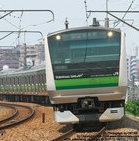Search the Community
Showing results for tags '103 series'.
-
Just to share with you how I converted the Kato 103 series Yamanote line train to DCC. I am not claiming that this is the best, the only or even a good way of doing it but it worked! The Kato 103 series is not at all DCC friendly so it took a lot of disassembly, soldering and re-assembly, and of course adjustment of CV values. Maybe not something for the faint-hearted. For the motor car, I used a Kuehn N45, simply because it is small, can handle the motor current and it was readily available at the shop I bought it. To make sure that I got the wiring right, I marked the forward direction and left and right side of the car. The carriage needed complete disassambly and the copper strips connected to the motor needed to be bended upwards to allow soldering of the wires. Same for the left and right hand rail power busbars. I do not solder on these strips while assembled in the carriage to prevent damaging (melting) the plastic parts. Initially I had the carriage lighting simply run on rail power, as recommended by Ken Shores of the famous http://www.sumidacrossing.org. That worked fine on my N700A Shinkansen but the 103 series has large windows and the whole thing looked way to bright. However this decoder has no wire leads for interior lights. Instead I connected the white lead, normally used for the front lights, to the Kato interior LED assembly. That could easily be done because this carriage sits in the middle of the train and does not have front nor rear lights. I needed to reconfigure the front light controls to become interior lights (function mapping to F1) and adjust the dimming to a mere 30% of the full brightness. During testrun I found that the train runs way too fast. Some 350 scale-km/h easily! Real slow running was difficult. So I lowered the default start value to the very minimum and halved the max power value. Obviously this is decoder dependent. Because the decoder is quite small (and flat) it does not appear visible behind the windows. The front and rear carriages are wired up with Doehler & Haass FH05B decoders to control the head and tail lights. The Kato 103 series still has old school light bulbs for front and rear lights, assembled with diodes on a small printed circuit board. To wire the decoder to the lightbulbs, the diodes needed to be removed. To dim and control the interior lights the KATO LED assembly is wired to the Aux 1 connection of the decoder and function mapped to F1 key. Again the interior light LEDs are dimmed to 30%. Now the other carriages still had their interior light run on rail power. So these needed to get their own decoders. In this case I soldered the decoder red and black leads to the clips that power the interior lights. To do that two small holes needed to be drilled in the bulkhead in front of the LED assembly. At the right, the holes in the bulkhead are just visible (where the red and black wires run through). All decoders in the train have the same DCC address, just to make it easy to control everything at the same time. So all lights go on and off at the same time. Not sure if that is prototypical. Maybe in reality someone is walking through the train and switches on/off the lights of the carriages one by one. In that case I could reconfigure everything to turn the lights on and off in a staggered way through iTrain. The complete train (with one carriage missing because otherwise the train would be too long for my testtrack) Another thing is that with lights on, the train is obviously empty, without passengers. Maybe I should now add standing and sitting passengers, e.g. by having a PS sheet fitted with figures glued to it. Of course the figures will need to be cut at their waist to get their heads at the right level behind the windows...
-
Those visiting Japan around this time of the year (there seem to be a few forum members who are/will do so) may be interested in buying a copy of the current JTB timetable. The cover feature is the 103 series, which is marking its 50th year of service. It may become a collectible, and certainly will be a nice souvenir of your trip. http://www.rurubu.com/book/recomm/jikokuhyou/








